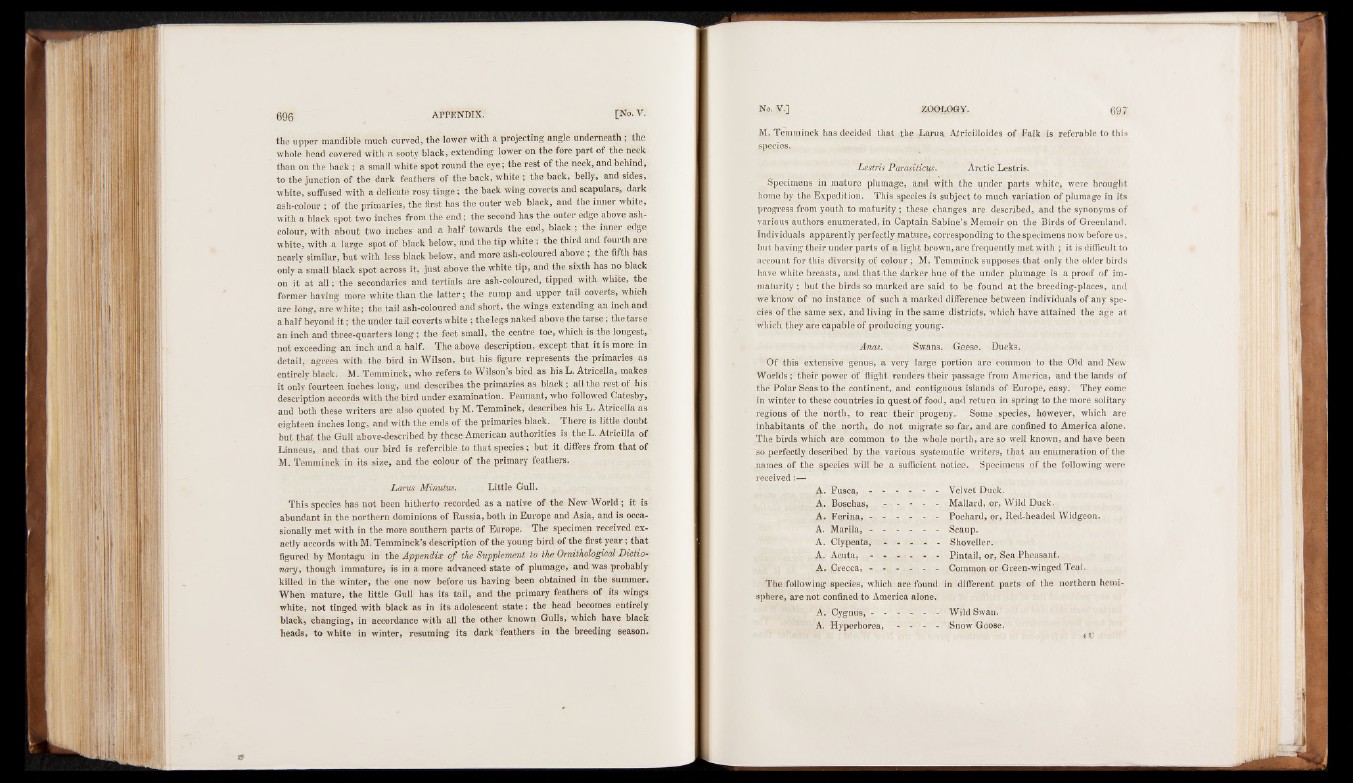
the upper mandible much curved, the lower with a projecting angle underneath ; the
whole head covered with a sooty black, extending lower on the fore part of the neck
than on the back ; a small white spot round the eye; the rest of the neck, and behind,
to the junction of the dark feathers of the back, white ; the back, belly, and sides,
white, suffused with a delicate rosy tinge; the back wing coverts and scapulars, dark
ash-colour ; of the primaries, the first has the outer web black, and the inner white,
with a black spot two inches from the end; the second has the outer edge above ash-
colour, with about two inches and a half towards the end, black; the inner edge
white, with a large spot of black below, and the tip white ; the third and fourth are
nearly similar, but with less black below, and more ash-coloured above ; the fifth has
only a small black spot across it, just above the white tip, and the sixth has no black
on it at all; the secondaries and tertials are ash-coloured, tipped with white, the
former having more white than the latter; the rump and upper tail coverts, which
are long, are white; the tail ash-coloured and short, the wings extending an inch and
a half beyond it; the under tail coverts white ; the legs naked above the tarse; thetarse
an inch and three-quarters long; the feet small, the centre toe, which is the longest,
not exceeding an inch and a half. The above description, except that it is more in
detail, agrees with the bird in Wilson, but his figure represents the primaries as
entirely black. M. Temminck, who refers to Wilson’s bird as his L. Atricella, makes
it only fourteen inches long, and describes the primaries as black; all the rest of his
description accords with the bird under examination. Pennant, who followed Catesby,
and both these writers are also quoted by M. Temminck, describes his L. Atricella as
eighteen inches long, and with the ends of the primaries black. There is little doubt
but that the Gull above-described by these American authorities is the L. Atricilla of
Linneus, and that our bird is referrible to that species; but it differs from that of
M. Temminck in its size, and the colour of the primary feathers.
Lams Minutus. Little Gull.
This species has not been hitherto recorded as a native of the New World; it is
abundant in the northern dominions of Russia, both in Europe and Asia, and is occasionally
met with in the more southern parts of Europe. The specimen received exactly
accords with M. Temminck’s description of the young bird of the first year; that
figured by Montagu in the Appendix of the Supplement to the Ornithological Dictio-
nary, though immature, is in a more advanced state of plumage, and was probably
killed in the winter, the one now before us having been obtained in the summer.
When mature, the little Gull has its tail, and the primary feathers of its wings
white, not tinged with black as in its adolescent state; the head becomes entirely
black, changing, in accordance with all the other known Gulls, which have black
heads, to white in winter, resuming its dark feathers in the breeding season.
No. V.] ZOOLOGY. 697
M. Temminck has decided that the Larus. Africilloides of Falk is referable to this
species.
Lestris Parasiticus. Arctic Lestris.
Specimens in mature plumage, and with the under parts white, were brought
home by the Expedition. This species is subject to much variation of plumage in its
progress from youth to maturity ; these changes are described, and the synonyms of
various authors enumerated, in Captain Sabine’s Memoir on the Birds of Greenland.
Individuals apparently perfectly mature, corresponding to the specimens now before us,
but having their under parts of a light brown, are frequently met with ; it is difficult to
account for this diversity of colour ; M. Temminck supposes that only the older birds
have white breasts, and that the darker hue of the under plumage is a proof of immaturity
; but the birds so marked are said to be found at the breeding-places, and
we know of no instance of such a marked difference between individuals of any species
of the same sex, and living in the same districts, which have attained the age at
Which they are capable of producing young.
Anas. Swans. Ge.ese. Ducks.
Of this extensive genus, a very large portion are common to the Old and New
Worlds; their power of flight renders their passage from America, and the lands of
the Polar Seas to the continent, and contiguous islands of Europe, easy. They come
in winter to these countries in quest of food, and return in spring to the more solitary
regions of the north, to rear their progeny.- Some species, however, which are
inhabitants of the north, do not migrate so far,, and are confined to America alone.
The birds which are common to the whole north, are,so well known, and have been
so perfectly described by the various systematic writers, that an enumeration of the
names of the species will be a sufficient notice. Specimens of the following were
received
A. Fusca, - - - - - - Velvet Duck.
A. Boschas, - - - - - Mallard, or, Wild Duck.
A. Ferina, - - - - - - Pochard, or, R,ed-headq(J Widgeon.
A. Marila, - - - - - - Scaup.
A. C ly p e ata ,......................Shoveller.
A. Acuta, - - - - - - Pintail, or, Sea Pheasant.
A* ,Grecca, - - - - - - Common or Green-winged Teal.
The following species, which are found in different parts of the northern hemisphere,
are not confined to America alone.
A. Cygnus, - - - - - - Wild Swan.
A. Hyperborea, - - - - Snow Goose.